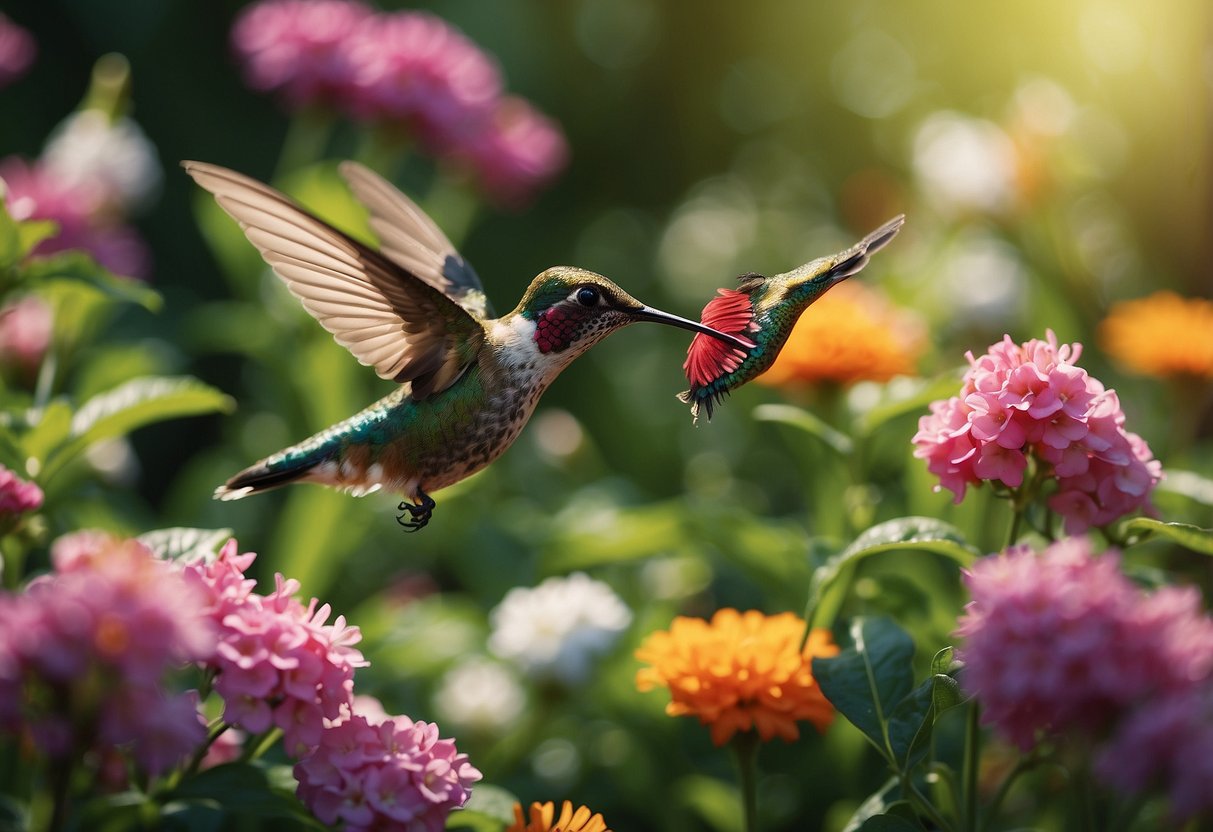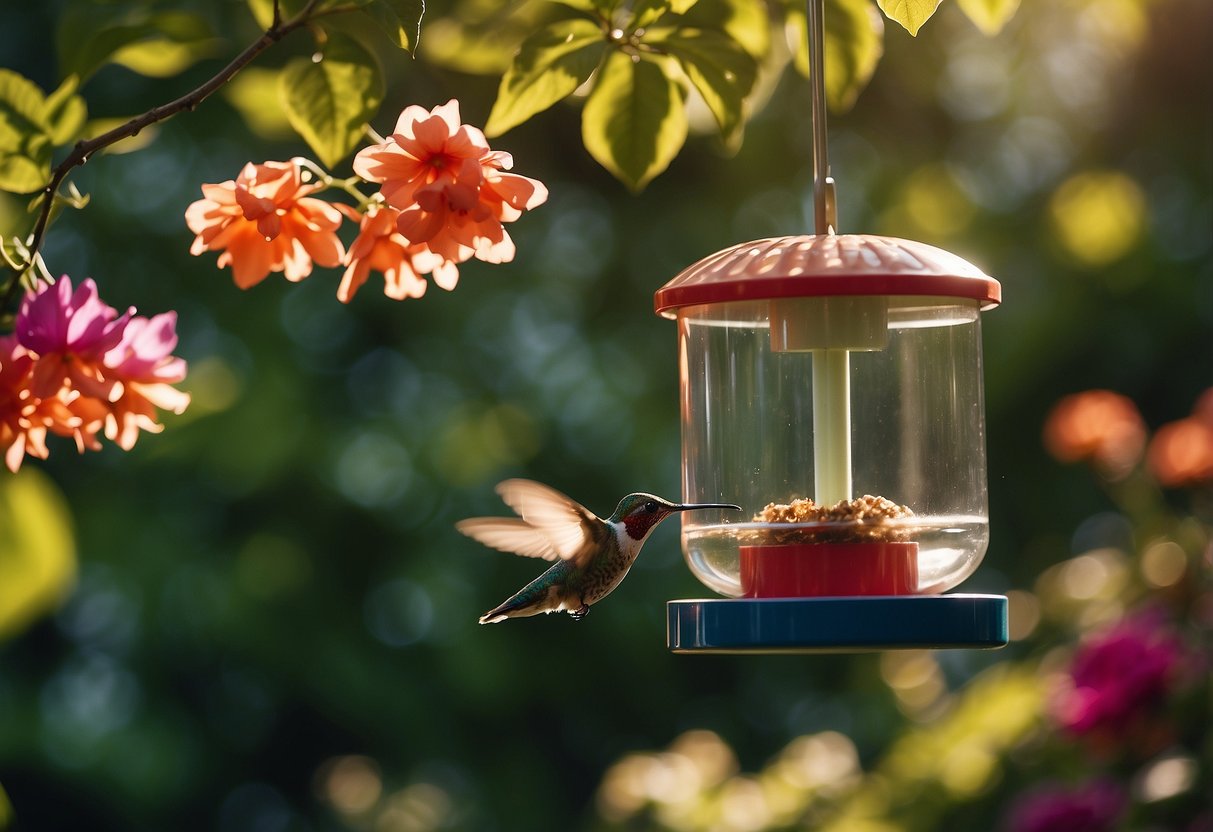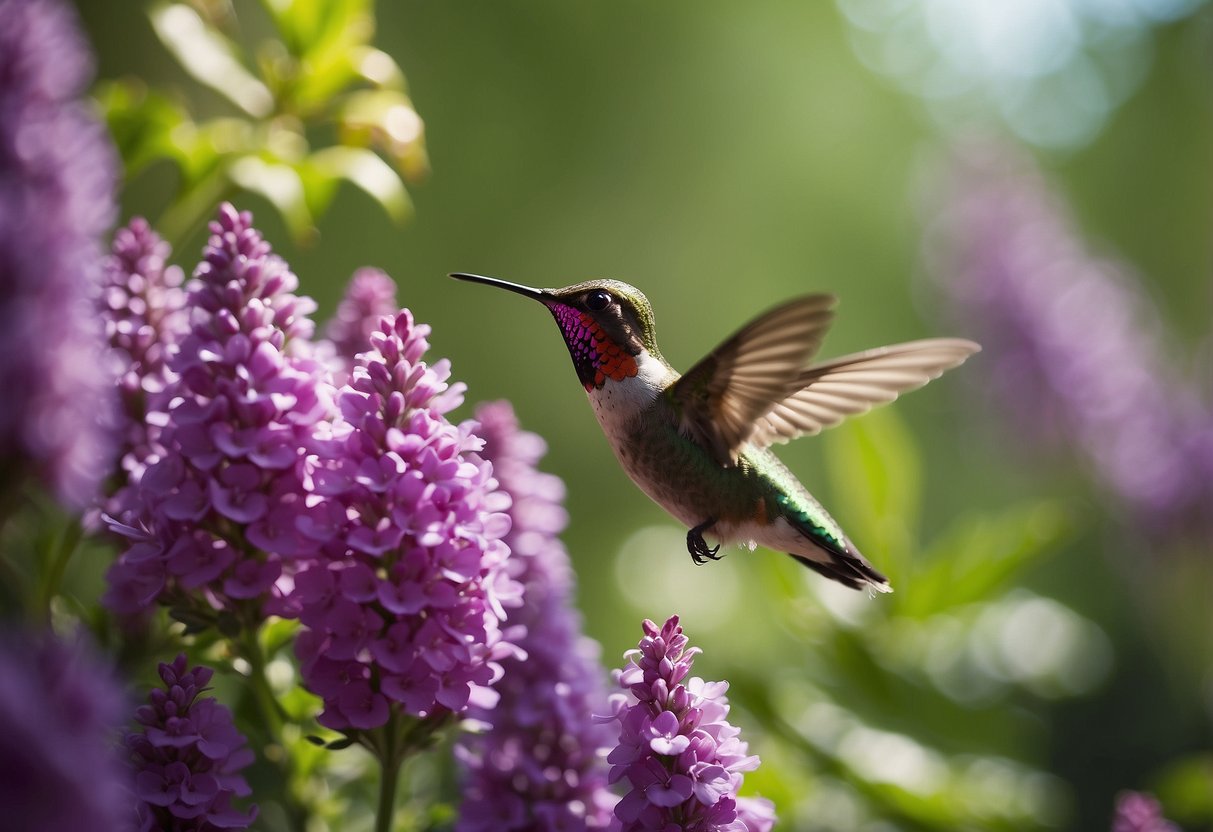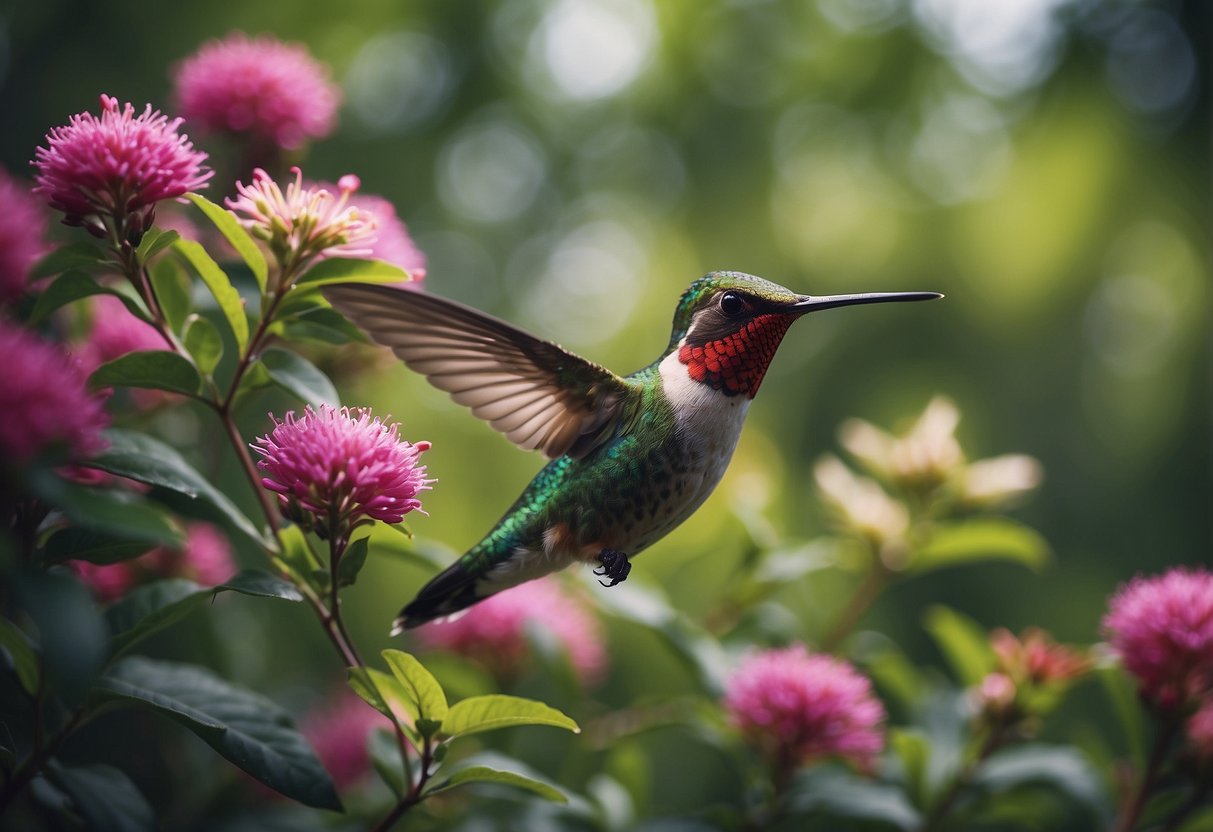Hummingbird Garden Ideas: Create a Vibrant Sanctuary
Creating a hummingbird garden can be a delightful and rewarding experience. These tiny, vibrant birds not only add beauty to your garden but also play a crucial role in pollination. How can you design your very own hummingbird paradise, buzzing with activity and color?

You don’t need a large space or a complex setup to attract hummingbirds. With the right plants, a few simple features, and a little patience, you can transform any yard into a haven for these fascinating creatures. By choosing the right elements, you’ll soon enjoy the sight and sound of hummingbirds gracing your garden.
1) Plant Native Flowers

Planting native flowers is one of the best ways to attract hummingbirds to your garden.
For example, the Anise Hyssop is a fragrant plant with purple flowers that hummingbirds love. It’s also resistant to browsing deer.
Columbine is another great choice. These flowers are inviting for hummingbirds and come in many species native to North America.
Try adding Salvia too. These flowers can grow up to 3 or 4 feet tall and are perfect for attracting birds to your garden.
2) Install a Hummingbird Feeder

Adding a hummingbird feeder to your garden is a great way to attract these tiny birds. You can make a simple feeder by repurposing a plastic bottle or using a wine bottle.
Another easy option is using a SOLO cup. Cut holes in the sides for the birds to access the nectar. Hanging it from a tree or hook ensures the feeder is within easy reach for the birds.
3) Create a Water Feature

Adding a water feature to your garden will make it more attractive to hummingbirds. You can use a solar-powered fountain which is both eco-friendly and easy to maintain.
Make sure the water flows gently, as hummingbirds prefer a soft trickle or drip. Check that the water feature is safe and stable by plugging in the pump and making any adjustments needed.
Place your water feature in a quiet area, close to flowers and plants that hummingbirds love. This way, they have easy access to both water and nectar.
4) Add Colorful Perennials

Colorful perennials can make your garden pop and attract hummingbirds. You can plant bee balm for its bright red, purple, pink, or white blooms. This plant grows vigorously and flowers from summer through fall.
Another great option is garden phlox. These fragrant flowers come in many varieties and bring in hummingbirds. Phlox grows well in zones 4 to 8 and has different heights and colors to suit your garden.
Consider adding Edda Clematis. This vine perennial blooms with purple flowers and red accents from late spring to late summer, making it a vibrant choice.
5) Grow Trumpet Vines

Trumpet vines are a fantastic choice for your hummingbird garden. These vines produce trumpet-shaped flowers in bright colors like red, orange, and yellow which attract hummingbirds.
You can grow trumpet vines in full sun to part shade. They can reach up to 40 feet in length, so make sure they have enough space.
It’s best to plant them with support like a trellis or arbor. This will help them climb and grow properly. By adding these beautiful vines, you’ll create an inviting spot for hummingbirds in your garden.
6) Include Tubular Flowers

Hummingbirds are attracted to tubular flowers because their long beaks and tongues can easily reach the nectar inside.
Consider planting Cape Fuchsia. This plant has clusters of red tubular flowers and does well in full sun and moist soil.
You might also like Weigela, a favorite of hummingbirds and butterflies. Its pink and reddish tubular flowers bloom from early spring to late summer, adding beauty to your garden for months.
7) Plant Flowering Shrubs

Adding flowering shrubs to your garden is a great way to attract hummingbirds. Rhododendrons, for example, come in many species and bloom in bright colors that hummingbirds love. You can find them in zones 4 to 10.
Garden phlox also works well. This plant has clusters of fragrant flowers that draw hummingbirds, especially in zones 4 to 8.
Another option is bee balm. Known for its vibrant red and pink flowers, it not only attracts hummingbirds but gives your garden a splash of color.
8) Use Hanging Baskets

Hanging baskets are a fantastic way to attract hummingbirds to your garden. They allow you to plant flowers that hummingbirds love, but don’t take up much space.
Flowers like fuchsias and trumpet vines are perfect for this. These plants are known for their bright colors and tubular shapes, which hummingbirds adore.
Hanging baskets can be placed on a porch, patio, or even a stake in your garden. This gives you plenty of flexibility in setting up your hummingbird-friendly space.
9) Incorporate Fuchsia Plants

Fuchsia plants are a wonderful addition to your hummingbird garden. These vibrant flowers have a unique shape that hummingbirds love. Their nectar-rich blooms provide a perfect food source.
You can easily propagate fuchsias by taking a 6-inch cutting and using a rooting hormone. Plant it in a small container and keep it moist.
Place the container in a shaded, warm spot to encourage growth. Once established, fuchsias will bring a splash of color and attract hummingbirds to your garden. Learn more about growing fuchsia plants for hummingbirds here.
10) Add Butterfly Bushes

Adding butterfly bushes to your garden can attract hummingbirds. These plants are known for their beautiful, fragrant blooms that come in many colors like purple, pink, and white.
Butterfly bushes provide nectar that hummingbirds love. They also attract butterflies and other pollinators, making your garden even more lively.
You can plant butterfly bushes in sunny spots where they can grow well. They are also drought-tolerant and easy to care for.
Designing a Hummingbird-Friendly Layout

To create a space that attracts and keeps hummingbirds coming back, focus on using the right plants and offering various feeding stations. This combination will ensure that these tiny birds find your garden both appealing and nourishing.
Choosing the Right Plants
Selecting the appropriate plants is essential for a successful hummingbird garden. It’s best to use native plants as they are well-adapted to your local climate and soil. These plants also offer the most nutritious nectar for hummingbirds. Opt for flowers with bright colors, especially reds and pinks, since hummingbirds are naturally attracted to these hues.
Think about planting a variety of species to ensure there’s something blooming throughout the season. Tubular-shaped flowers are particularly appealing to hummingbirds because their long beaks can easily access the nectar. Good choices include trumpet vine, bee balm, and columbine.
Layer your garden vertically by using trellises, window boxes, and pots to create different levels. This not only maximizes space but also provides multiple feeding spots, increasing the chances of attracting more hummingbirds. For more details, check out this hummingbird garden guide.
Creating Feeding Stations
In addition to planting flowers, installing feeding stations is a great way to attract hummingbirds. There are various feeding devices available, including misters, drip fountain devices, and small waterfalls, which provide both water and visual attraction to hummingbirds. Simple sugar-water feeders also work well and should be cleaned regularly to prevent mold and bacteria growth.
Place these feeders in sunny spots as hummingbirds are more likely to visit areas that receive a lot of sunlight. Aim to have multiple feeders around your garden to minimize competition and territorial disputes among the birds. You can find more ideas for feeding stations in this comprehensive hummingbird garden article.
Creating a space that appeals to hummingbirds doesn’t have to be complicated. By choosing the right plants and setting up dedicated feeding stations, you’ll create a haven for these delightful little birds.
Maintaining Your Hummingbird Garden

Caring for your hummingbird garden means regular watering, occasional pruning, and keeping the area free from pests. These steps help ensure a healthy and vibrant environment for the hummingbirds to enjoy.
Watering and Pruning Tips
Make sure your plants get enough water. Hummingbird-friendly plants often need regular watering, especially during dry periods. A drip irrigation system or a soaker hose is great for this, as it delivers water right to the roots without too much runoff.
Pruning is also important. Trimming back dead or overgrown branches helps your plants stay healthy and produce more flowers. This means more nectar for the hummingbirds. Deadheading, or removing spent flowers, encourages new blooms too.
Water in the early morning or late evening. This reduces evaporation and ensures your plants get enough water. Overwatering can harm some plants, so always check the soil moisture before adding more water.
Protecting Your Garden from Pests
To keep pests away, use natural methods. Beneficial insects like ladybugs can help control harmful pests. You can attract these helpful bugs by planting dill, fennel, or cilantro nearby.
Avoid using chemical pesticides. They can harm hummingbirds and other wildlife. Instead, try homemade remedies like a mixture of water and dish soap to spray on pests. This is safe for plants and effective against bugs like aphids.
Creating physical barriers is another good method. Fences or netting can keep larger pests, like deer or rabbits, out of your garden. Regularly check your plants for any signs of pest damage and take action immediately to prevent bigger problems.
Keeping your garden pest-free ensures that hummingbirds have a safe and healthy place to visit.







